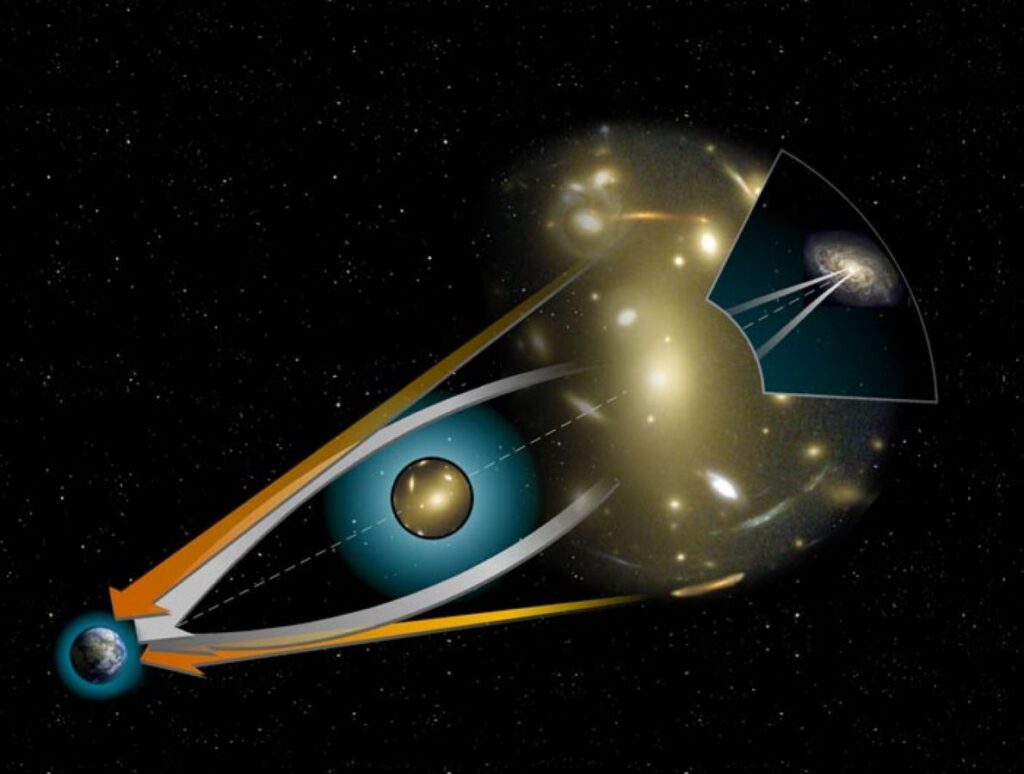Imagine looking up at the night sky and wondering—not if aliens exist—but if they’ve been watching us all along. Now, take that thought further: what if they weren’t watching humans at all, but dinosaurs? Some scientists have toyed with this mind-bending idea, suggesting that if extraterrestrials are observing Earth from light-years away, they might be seeing it as it was 65 million years ago. Thanks to the way light travels across the universe, distant civilizations could, in theory, be witnessing giant sauropods grazing or a Tyrannosaurus on the hunt right now. It’s a fascinating mix of astronomy, paleontology, and imagination that challenges how we think about both time and alien life.
The Mind-Bending Physics of Light Travel

Imagine an alien civilization pointing their most advanced telescope toward Earth from a galaxy roughly 65 million light-years away. What would they see? The answer might blow your mind. Because of the finite speed of light, when you gaze up into the night sky, you are looking into the past. This fundamental principle means that if there are intelligent aliens in this galaxy, when they look at the Milky Way, they are seeing our galaxy as it was at the time of the dinosaurs.
Think about it this way: light hitting your eye tonight has been traveling for 8.6 years just from the bright star Sirius. The same principle applies across vast cosmic distances, creating a natural time machine effect. If light and sight behave as I explained to you above, then theoretically, an alien 65 million light-years away should be able to see dinosaurs on Earth. The light that bounced off the dinosaurs 65 million years ago will reach this far-off planet right now, enabling aliens to see them.
When Dinosaurs Roamed and Light Began Its Journey

The extinction event that wiped out the dinosaurs happened approximately 66 million years ago, marking the end of the Cretaceous period. The light that left The Earth back then is now 66 million light years away. This creates an extraordinary scenario where light carrying information about T-Rex, Triceratops, and all their prehistoric companions is still traveling through space at this very moment.
But here’s where it gets really fascinating. Were dinosaurs the only object light bounced off of 65 million years ago? Definitely not. Every tree, every mountain, every cloud, and every single detail of Earth’s ancient landscape is encoded in photons that are currently racing toward distant galaxies. It’s like the universe has created the ultimate time capsule, scattered across cosmic distances.
The Massive Telescope Problem

Now comes the reality check that might crush your alien-watching-dinosaurs dreams. Even the wildest theoretical technologies that anybody has ever imagined would not be nearly powerful enough to see dinosaurs on Earth from such a great distance. The scale of what would be required is almost incomprehensible.
To see dinosaurs on Earth, as a dot, the diameter of this lens should be more than 4.5 light years, bigger than Earth itself! That’s roughly the distance between our Sun and the nearest star system. Imagine trying to build a telescope lens that spans that entire distance. According to nuclear physics, a body this huge cannot exist in space. There are some mass density rules our universe follows.
What Current Technology Can Actually Achieve

For an estimate, consider the world’s most powerful telescope, the James Webb Space Telescope. Its main lens has a diameter of 6.5 meters and a resolution of 0.1 arc seconds, which means that this telescope can easily spot a penny more than 40 km away. That sounds impressive, but when you scale it up to intergalactic distances, it’s like trying to spot an ant on the moon with a magnifying glass.
Using current technology, astronomers cannot resolve any details on even the biggest planets orbiting the nearest stars. Dinosaurs are much much smaller than a whole planet, and NGC 4845 is millions of times farther away. Even our most advanced instruments would see Earth as nothing more than a tiny speck of light, if they could detect it at all.
The Challenge of Scattered Light

Here’s another obstacle that would make alien dinosaur-watching nearly impossible: light scatter. When the distance between our eye and the object is less, the photons aren’t able to scatter much before they reach the eye. But the greater the distance, the more these photons will scatter. Over 65 million light-years, photons carrying dinosaur information would be scattered and mixed with countless other light sources.
Think of it like trying to hear a whisper in a crowded stadium during the Super Bowl. The original signal gets completely drowned out by all the noise around it. The light from stars and galaxies that existed millions or billions of years ago has traveled through space and reached Earth, but it is often drowned out by the much brighter light from more recent sources. This makes it difficult to detect the faint light from the era of the dinosaurs.
Theoretical Super-Telescopes and Their Limits

Scientists have proposed some wild telescope concepts that push the boundaries of what might theoretically be possible. The largest version of LUVOIR would boast a primary mirror 15 meters wide, bringing it to the limit of what could fit within the world’s largest rockets. But even these ambitious designs fall dramatically short of what would be needed.
This broad concept envisions the detection of surface features of exoplanets through the use of space-based fleets of many meter-scale mirrors flying in formation to create virtual telescopes larger than any single one ever could be. While fascinating, these hypertelescope concepts would still be inadequate for spotting individual dinosaurs across such vast distances.
The Solar Gravitational Lens Possibility

One of the most intriguing theoretical approaches involves using our own Sun as a giant magnifying lens. Even the wildest theoretical technologies that anybody has ever imagined (such as using the Sun as a magnifying lens) would not be nearly powerful enough to see dinosaurs on Earth from such a great distance. The gravitational field of the Sun can actually bend light, creating a natural telescope of sorts.
However, Each exoplanet targeted for solar gravitational lensing would probably require its own dedicated Hubble-like space telescope sent to and operated at the solar system’s outer limits. For such an observatory to image a second exoplanet just 10 degrees off from its original target, it would need to shift its position around the sun by more than 14 billion kilometers. The logistical challenges are staggering.
What Aliens Might Actually See

So what could a hypothetical alien civilization with advanced technology actually observe when looking at Earth from 65 million light-years away? Even with this huge telescope, planet earth will only appear as a dot to our alien friend. They might detect that our planet exists, and if they’re extremely advanced, they might even determine some basic atmospheric composition.
Seeing the Milky Way as it was at the time of the dinosaurs is not the same as actually being able to see individual dinosaurs! It’s the difference between knowing a house exists on a street versus being able to see the individual ants crawling around in its backyard. The scale differential is just too enormous.
Modern Telescope Breakthroughs

Today’s most advanced telescope, the James Webb Space Telescope, is revolutionizing our understanding of distant galaxies. In May 2024, the JWST identified the most distant known galaxy, JADES-GS-z14-0, seen just 290 million years after the Big Bang, corresponding to a redshift of 14.32. These capabilities show us just how far we’ve come in astronomical observation.
The James Webb Space Telescope may have broken another of its own records, finding potentially five of the earliest and most distant galaxies ever seen. Yet even with these incredible achievements, we’re still talking about observing entire galaxies, not individual creatures on distant planets. The technological leap required to spot dinosaurs would be exponentially greater than what we’ve achieved so far.
Future Possibilities and Wild Ideas

Scientists aren’t giving up on the dream of seeing alien worlds in detail. A simpler path stays within today’s engineering reach: swap the round mirror for a rectangular one measuring roughly 1 meter by 20 meters, operating at about the same 10-micron wavelength as JWST. The long axis delivers the crucial 20-meter resolving power in one direction, enough to separate a planet from its star at 30 light-years.
If we could build a network of small optical telescopes distributed throughout the Solar System, we’d only get the light-gathering power of the sum of the areas of all of the individual telescopes, but we’d get the resolution of the separation between the telescopes! It’s an incredible challenge, but if we can rise to it, we just might be able to image a greater level of detail than optical astronomers have ever thought possible.
The Verdict on Alien Dinosaur Watchers

So, theoretically, the answer is yes. But practically, the truth is a lot more complicated. While the physics of light travel makes it theoretically possible for aliens to receive photons that once bounced off dinosaurs, the practical challenges of building a telescope capable of resolving such details are insurmountable with any known or proposed technology.
Ultimately, while the concept is intriguing, technological and physical constraints make it implausible for aliens to witness dinosaurs on Earth from 65 million light years away. The universe has indeed created a natural time machine, but one that requires technology so advanced it borders on magic. For now, the dinosaurs remain safely hidden in the cosmic static, their secrets preserved in light that may never be decoded by alien eyes.
So next time you look up at the stars, remember that somewhere out there, light carrying the image of you reading this very article is beginning its own incredible journey through space. Will alien astronomers 65 million years from now wonder if they could see you? The answer remains as mysterious as the cosmos itself.



